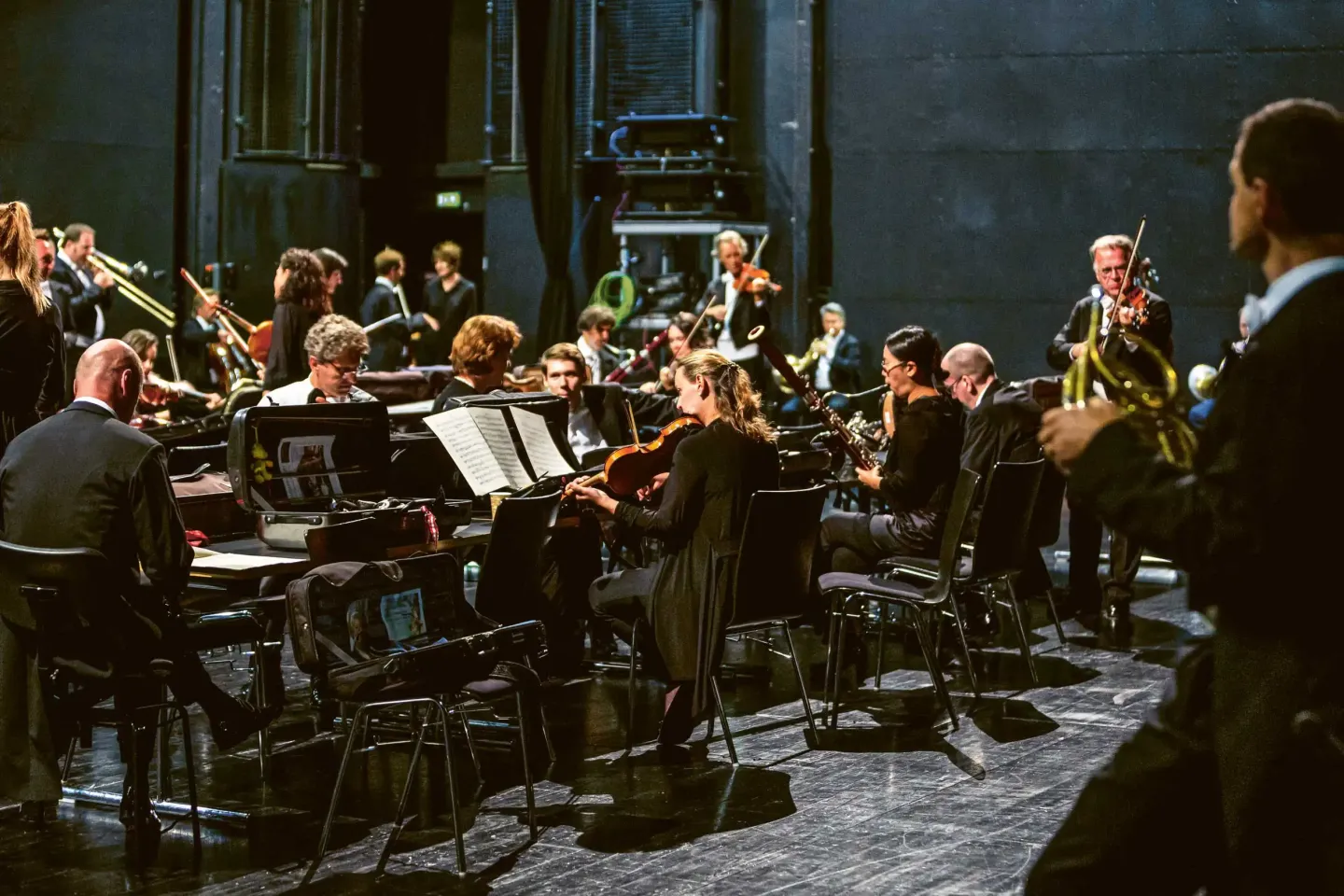Text: Babette Karner
The text was published in edition 3 (06/25).
Reading time 3 Min.
Tetris in the Orchestra Pit
The performance of George Enescu’s Œdipe in Bregenz is not just a musical but also an organizational challenge: art, sound, and logistics must align in perfect coordination.
When George Enescu’s choral opera Œdipe is staged at the Bregenzer Festspiele in summer 2025, it marks not only a musical highlight, but also a logistical feat. Some operas are rarely performed not because of artistic limitations, but simply because they exceed the spatial capacities of many opera houses. Œdipe, deeply rooted in the tradition of French grand opera, is one of them: It fills the orchestra pit of the Festspielhaus to the very edge of what’s physically feasible.
Great, Greater – Grand Opera
There is no fixed standard for the size and instrumentation of opera orchestras – contrary to what layperson might assume. The more than 400-year-old art form has evolved continuously ,and with it, the orchestra. In 19th-century Paris, for example, Grand Opera was more than a musical event: it was spectacle, representation/display of grandeur, and a sonic large-scale format – with everything that entails: extended ballet scenes, opulent choral passages/choirs, special instrumentation, and one firm rule that distinguished it from other stage genres: no spoken dialogue. “Enescu’s Œdipe, composed in the early 20th century, carries that DNA within it,” says Head Dramaturge Florian Amort, who is also responsible for the dramaturgy of Œdipe. “It’s a powerful work with an extraordinary orchestral setup that rarely appears in performance schedules. Not because it lacks artistic merit, but simply because its instrumentation is too large for many (opera) houses.” Due to a relatively small orchestra pit at the Coburg Theatre/Landestheater Coburg, Richard Wagner already approved performances of his works using reduced orchestrations/orchestral setups. Richard Strauss followed suit and authorized arrangements of his operas for smaller orchestras, which his publisher distributed internationally under the name Coburg version. “A very pragmatic – but also financial – decision: it shows how artistic choices were often shaped by economic constraints.”

Orchester hinter den Kulissen: Die Wiener Symphoniker beim Einspielen auf der Hauptbühne
Precision in Every Detail
In addition to the standard instruments, Enescu’s partitura calls for a harmonium, celesta, two harps, a saxophone, and both a wind and thunder machine. All of these require significant space. Yet the orchestra pit in the Festspielhaus, designed for versatile use, has its limits: “We can’t enlarge the pit, and there’s no understage area or other additional space in the Große Saal to accommodate all the required instruments.” The consequence: The orchestration/instrumentation for Œdipe must be custom-designed. The conductor plays a central role, as do the orchestra managers and stage managers. Together, they develop a personnel plan that is musically viable and logistically feasible. “It’s like playing Tetris in the orchestra pit,” says Amort. For instance, Enescu’s original scoring calls for 14 first violins – here reduced to ten players/musicians. Does that change the overall sound? “A bit. But the conductor can balance that sensitively.”
One of the most unusual instruments in Œdipe is the singing saw – a non-traditional instrument used for sound effects played with a double bass bow. “The saw gives the Sphinx – a central figure in the Oedipus myth – her pervasive, ghostly cry, a sound that seems to come from a pre-modern world,” Amort explains.
“Today, you could easily produce that effect digitally. But in Bregenz, it was done by hand – stage magic in the purest sense.”
Versatile Talents in the Pit
In Œdipe, music is not only heard from the orchestra pit. Enescu also composed passages for flutes and harp to be played from backstage. To do this, musicians leave their seats in the pit, play behind the stage, and then return to their places, Amort explains. “It’s a combination of logistics and choreography that demands the highest precision”. Special focus in Œdipe is placed on percussion – a section that has seen the greatest instrumental expansion since 1900. Four percussionists are involved, many/a lot more than in most operas. They play not only timpani, cymbals, and drums, but also non-traditional instruments used for sound effects just like the singing saw. “It takes not just musical skill but also curiosity and a spirit of experimentation. Percussionists are the multi-talents of any orchestra – in Œdipe, their versatility is essential to a successful performance,” Amort notes.
A Sound Production with Structure
What appears to the audience as a grand moment of musical theater follows a meticulously planned sequence behind the scenes – a process managed by the orchestra managers. All instruments, music stands, seating, and procedures are prepared in advance so that the musicians can take their places and begin playing without delay. “For a large-scale production like Œdipe, this is a complex task,” Amort explains, “because the Festspielhaus is continuously used for other performances during the summer season. That means the technical crew may have to reconfigure the entire setup several times a day: rehearsal in the morning, changeover in the afternoon, new production in the evening. It’s a massive effort.”
Despite all the creative solutions that go into such a production, there are some pieces/works that simply cannot be realized at the Bregenz Festspielhaus, Amort concedes: “Richard Strauss’s Elektra, for example, or large-scale operas by Stockhausen are practically unstageable here under current conditions. But with Œdipe, we’ve found a solution – thanks to careful adaptation, creative compromise, and a committed team effort – that meets the demands of the piece in every respect, both musically and logistically.”
Orchestra behind the scenes: The Wiener Symphoniker warming up on the main stage.
Œdipe
George Enescu
16 July 2025 – 7.30 p.m. premiere
20 July – 11.00 a.m.
28 July – 7.30 p.m.
Festspielhaus, Großer Saal


